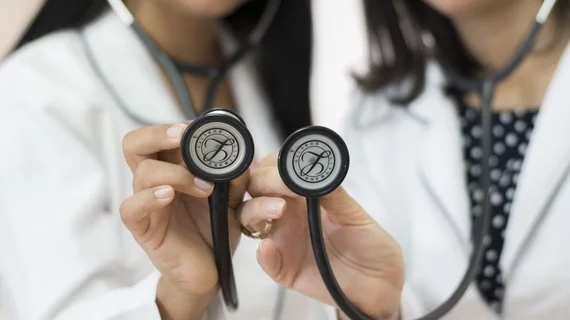Cardiologist compensation hits $622K, up 32% from 10 years ago
The median compensation for U.S. cardiologists was $621,596 in 2021, according to a new in-depth survey from MedAxiom, an American College of Cardiology (ACC) company. This represents an increase of nearly 32% compared to 2011, but the jump has been much more significant for cardiologists at private practices (from $457,661 to $604,652) than those at integrated practices (from $549,999 to $621,596).
MedAxiom’s 10th annual Cardiovascular Provider Compensation and Production Survey Report includes input from more than 5,500 cardiovascular providers, including more than 2,000 cardiologists. The median size of programs responding to the survey was 11 full-time equivalent (FTE) physicians.
“The past decade has brought many interesting and revealing changes to the practice of cardiology,” report co-author Joel Sauer, MBA, MedAxiom’s executive vice president of consulting, said in a statement. “From procedure shifts and the mix of cardiologists to the production and compensation alterations that result, it has been a dynamic 10 years. While no one can predict the future, the beauty of surveys is their ability to measure the past. MedAxiom is looking forward to the next 10 years of cardiology surveys to provide the community with invaluable data and peer comparisons.”
The report highlighted several key trends in cardiology. For example, 89% of cardiology programs are now owned by a hospital or health system, a sign that ownership models in the specialty are continuing to shift as they have been for the past decade. In 2011, just 48% of cardiology programs were owned by a hospital or health system.
In addition, compensation for private practice cardiologists is just 3% lower than those at integrated practices. The report’s authors noted that the gap between the two was 20% just four years ago.
Some statistics have bounced back to pre-pandemic levels—some are still just slightly behind
As high as cardiology’s compensation numbers appear to be, they are not as high as they were before the pandemic. In 2019, for example, cardiologists had a median compensation of nearly $635,000, a number that the specialty has not caught up with quite yet.
The number of new patient visits per FTE cardiologist, however, were higher in 2021 (a median of 622) than in 2019 (602) after taking a considerable dip in 2020 (527). This same trend was also seen for new ambulatory patients; the number was higher in 2021 (a median of 361) than it was in 2019 (349) after dropping in 2020 (311).
“While total new patients are important for measuring the vitality of a cardiology practice, MedAxiom considers the ambulatory new patient count the true barometer of a healthy system,” according to the report’s authors. “This is because hospital-based patients are a captive audience. A patient presenting to the emergency department with chest pain is most likely going to see the cardiologist who happens to show up; they are unlikely to leave and shop for someone different. On the ambulatory side, however, it is not uncommon for this to happen. If a primary care physician makes a referral to cardiology and—without having to negotiate through personal phone calls—the lag time is several weeks out for the appointment, he/she may look for alternatives.”
The latest data on cardiac imaging
Also, according to MedAxiom, the three primary advanced imaging modalities used by cardiologists—coronary CT angiography (CCTA), cardiac PET and cardiac MR—are all being used now more than ever. In 2021, the median number of advanced studies per 1,000 active cardiology patients was 23 for CCTA, 32 for cardiac PET and five for cardiac MR. This all comes at a time when 34% of programs offer CCTA, 16% offer cardiac PET and 22% offer cardiac MR.
Read the full report
These takeaways represent just some of the information included in MedAxiom’s thorough report. The full document is available here as a PDF.

